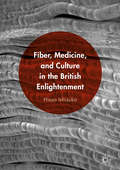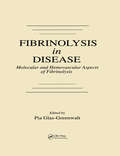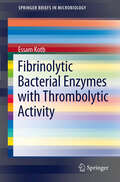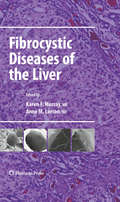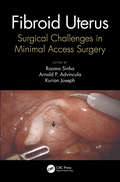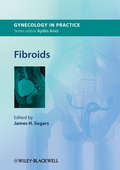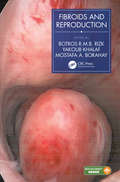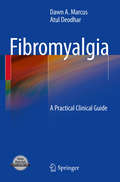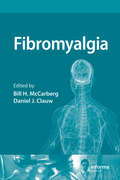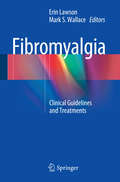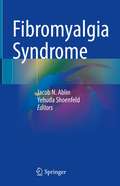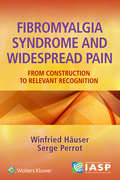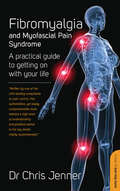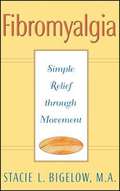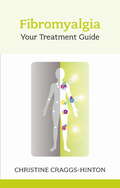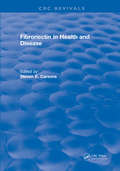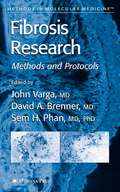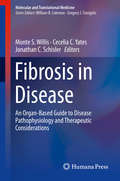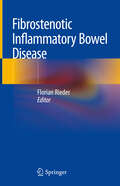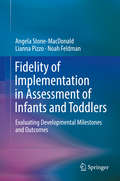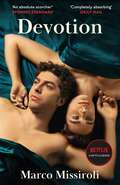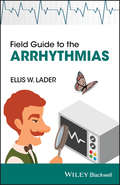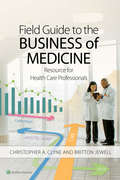- Table View
- List View
Fiber, Medicine, and Culture in the British Enlightenment
by Hisao IshizukaThis book provides a full account of the concept of fiber and fiber theory in eighteenth-century British medicine. It explores the pivotal role fiber played as a defining, underlying concept in anatomy, physiology, pathology, therapeutics, psychology, and the life sciences. With the gradual demise of ancient humoralism, the solid fibers appeared on the medical scene both as the basic building unit of the body and as a dynamic agent of life. As such, fiber stands at the heart of eighteenth-century medicine, both iatromechanism and iatro-vitalism. Touching on the cultural aspects of fiber, the Baroque, and the culture of sensibility, this book also challenges the widely held assumption that the eighteenth century was the age of the nerve and instead offers an alternative model of fiber.
Fibrinolysis in Disease - The Malignant Process, Interventions in Thrombogenic Mechanisms, and Novel Treatment Modalities, Volume 2
by Pia Glas-GreenwaltFibrinolysis in Disease reviews the state of the art of basic and clinical aspects of the fibrinolytic enzyme system. The text, authored by outstanding and internationally known investigators, is presented in two books.The Malignant Process, Interventions in Thrombogenic Mechanisms, and Novel Treatment Modalities discusses the molecular biology of the system's key components and their fundamental roles in a variety of thrombotic and metabolic disorders. Molecular and Hemovascular Aspects of Fybrinolysis presents the latest findings and concepts of the association between plasminogen activator (u-PA) overexpression and abnormal growth regulation in a variety of solid tumors and in leukemia. One chapter deals with various successful interventions in thrombogenic mechanisms, ranging from exercise and diet to anticoagulants and direct and indirect thrombolytic agents. It concludes with a projection of exciting, novel treatment modalities in thrombotic and malignant diseases.
Fibrinolytic Bacterial Enzymes with Thrombolytic Activity
by Essam KotbStress, high blood pressure, smoking, pollution, fast foods, overweight, excessive travelling, surgery, less movement are common features in our modern life. These features are risky for blood clotting disorders. According to WHO, over 29% of the total mortalities worldwide are due to thrombosis. By the year, 2020 cardiovascular diseases (CVDs) may cause an estimated 25 million deaths per year, thus antithrombotic therapy is of great interest. The available thrombolytic agents such as urokinase are highly expensive, antigenic, quite unspecific, pyretogenic and hemorrhagenic. Therefore, the production of fibrinolysing enzymes, which rapidly dissolute thrombi within the vascular tree, without the detriments by microorganisms, as described in this book, is the desirable aim of today's research.
Fibrocystic Diseases of the Liver
by Karen F. Murray Anne M. LarsonIn recent years there have been huge advances in the understanding of the genetic and molecular basis of the fibrocystic diseases. This volume provides a thorough review of fibrocyctic diseases that affect the liver. It contains in-depth discussions of the genetics, molecular biology, pathogenesis, histology, clinical presentations, complications of, treatment, and prognosis of the conditions affecting children and adults, and hence will be the gold-standard reference for these conditions. In addition, the histological features that distinguish these conditions from other potentially fibrosing hepatopathies are illustrated. Conditions with syndromic features involving the kidney or other organ systems are also reviewed. Thorough review of the clinical phenotypes, their presentations, treatment, potential complications of, and prognosis is discussed. Fibrocystic Diseases of the Liver will be an invaluable resource for hepatologists, gastroenterologists, nephrologists, and hepatic surgeons who care for children and adults with liver disease, as well as basic scientists in molecular genetics, hepatobiliary pathophysiology, hepatology and nephrology.
Fibroid Uterus: Surgical Challenges in Minimal Access Surgery
by Rooma Sinha Kurian Joseph Arnold P. AdvinculaThis book on fibroid uterus focuses on surgical challenges in minimal access surgery that a surgeon faces while treating this condition. This book explores the role of various imaging modalities in both diagnosis and planning of the treatment. Various surgical techniques, such as hysteroscopy, laparoscopy, and robotic are discussed which will help readers to understand the pros and cons of each one. Teaching practical tips from experts regarding these procedures, the book aims to help surgeons make clinical decisions while they choose surgical procedures for their patients in various clinical settings. The book highlights both the conservative (techniques of myomectomy) and hysterectomy by various methods for treating fibroids. Key Features How to use various imaging modalities for preoperative evaluation of fibroids Issues in preoperative counseling and consent before surgery for fibroids Overview of surgical treatment of fibroids Individual chapters on practical tips by experts for various surgical techniques used for both myomectomy and hysterectomy Discusses the controversy in morcellation and how to perform it safely Covers the problem of parasitic fibroids that have increased in recent times Discusses issues like breach in endometrial cavity during myomectomy, surgery for adenomyosis, uterine rupture and recurrence after myomectomy When to call it a day and convert from laparoscopy to laparotomy
Fibroids (GIP - Gynaecology in Practice)
by James H. SegarsFibroids are benign growths of the uterus. They are the most common tumours found in women (20-30% of women), usually in later reproductive years. This book covers evidence-based indications for treatment of uterine fibroids in gynecology, the management of fibroids in pregnancy, surgical treatments and outcomes, rare fibroid syndromes, and more.
Fibroids and Reproduction
by Botros R.M.B. Rizk, Yakoub Khalaf and Mostafa A. BorahayThe most common abnormal growth of the female reproductive system, fibroids, are thought to affect the majority of women at some point during their reproductive years. This text from leading fibroid experts looks at the latest evidence on how the problem impinges on reproduction and the most up-to-date management and treatment options available to help patients with fibroids hoping to conceive. Print versions of this book also include access to the eBook version with links to procedural videos.
Fibromyalgia
by Atul Deodhar Dawn A. MarcusCaring for patients with fibromyalgia requires an understanding of the complex nature of this condition. Fibromyalgia: A Practical Clinical Guide is a state-of-the-art resource designed to clarify the controversy about fibromyalgia and to provide clinicians with the latest information about its pathogenesis and clinical evaluation, as well as evidence-based guidelines for effective treatment. This comprehensive title includes fully referenced, practical information on this fast-emerging field and provides useful clinical suggestions and practical office tools for effectively managing patients. The good news for fibromyalgia patients and their healthcare providers is that a wide range of medication, non-medication, and non-traditional therapies have been proven to effectively reduce some of the most problematic and disabling fibromyalgia symptoms. Brief case vignettes help describe many of the common presentations, concerns, and complexities typically seen in fibromyalgia patients. Invaluable graphic aids -- boxes, tables, and figures - are used widely to provide quick reference for the busy clinician seeking information. In addition, clinic-proven assessment and documentation tools for evaluating and monitoring fibromyalgia symptoms and severity are provided, along with handouts for patients to provide guidance on pain management techniques, including detailed exercise and relaxation technique instructions. A unique addition to the literature, Fibromyalgia: A Practical Clinical Guide is an indispensable reference for all clinicians who care for patients with fibromyalgia.
Fibromyalgia
by Bill H. McCarberg Daniel J. ClauwUtilizing evidence-based research, this revolutionary source explores the difficult diagnosis and management of the controversial syndrome of fibromyalgia. Carefully guiding physicians through the steps leading to diagnosis, Fibromyalgia emphasizes targeting the underlying fibromyalgia syndrome rather than treating each of its symptoms individually
Fibromyalgia
by Erin Lawson Mark S. WallaceThis practical text provides a clinical overview of the etiology, diagnosis and treatment for fibromyalgia. Current evidence-based treatments and guidelines are emphasized along with lifestyle modification suggestions for the patient. Also included is a review of current literature, research and emerging developments on this prevalent pain syndrome. A range of healthcare specialties, including pain management, rheumatology, neurology, internal medicine and family practice, will find this comprehensive guide to be a valuable resource to their routine treatment of fibromyalgia and improve patient's quality of life.
Fibromyalgia Syndrome
by Yehuda Shoenfeld Jacob N. AblinThis book provides a comprehensive overview of fibromyalgia syndrome that focuses on integrating concepts relevant to the pathogenesis, epidemiology and treatment of the condition. Details of how to manage sleep disorders, assess related disabilities, use pharmacological and complementary treatments are provided. Relevant aspects of neuromodulation, genetics, and neuromodulation are also covered. Therefore, enabling the reader to develop a deep understanding of the underlying triggers of and tools for assessing and treating fibromyalgia. Fibromyalgia Syndrome features a wealth of information on the basic science and contains guidance on how to make clinical decisions when treating patients with this condition, and is a valuable resource for any medical professional or trainee seeking a dedicated up-to-date resource on the topic.
Fibromyalgia Syndrome and Widespread Pain: From Construction to Relevant Recognition
by Winfried Hauser Serge PerrotPublisher's Note: Products purchased from 3rd Party sellers are not guaranteed by the Publisher for quality, authenticity, or access to any online entitlements included with the product. Published under the auspices of the International Association for the Study of Pain, Fibromyalgia Syndrome and Widespread Pain: From Construction to Relevant Recognition offers a holistic guide to the understanding and management of fibromyalgia syndrome (FMS), bringing together contributors and approaches from the worlds of medicine, complementary medicine, physical therapy, pharmacology and psychology. A unique and necessary approach to this debilitating condition!
Fibromyalgia and Myofascial Pain Syndrome: A Practical Guide to Getting on With Your Life
by Chris JennerWritten by one of the UK's leading consultants on pain control, this authoritative, yet easily comprehensible book, delivers a high level of understanding and practical advice to the lay reader. Highly recommended. Manage your Fibromyalgia by becoming an expert patient. There really is life after being diagnosed with fibromyalgia or myofascial pain syndrome...and yours starts here. The lack of knowledge which surrounds two of the most prevalent illnesses in the world today means that they can often go undiagnosed and untreated for years, during which time both the mental and physical condition of sufferers can deteriorate considerably. With the right care, there is much that can be done to help anyone with these conditions to improve their quality of life dramatically. The first step towards that is by doing precisely what you are doing now, educating yourself. Within the covers of this book, you will find an easy-to-read and practical guide to dealing with fibromyalgia and myofascial pain. Dr Chris Jenner takes a straightforward and down-to-earth look at what these two conditions are about; how they might affect different aspects of your life; what your options are; and how you can get on with your life.
Fibromyalgia and Myofascial Pain Syndrome: How to manage this painful condition and improve the quality of your life
by DR Chris Jenner MB BS, FRCA, FFPWritten by one of the UK's leading consultants on pain control, this authoritative, yet easily comprehensible book, delivers a high level of understanding and practical advice to the lay reader. Highly recommended. Manage your Fibromyalgia by becoming an expert patient. There really is life after being diagnosed with fibromyalgia or myofascial pain syndrome...and yours starts here. The lack of knowledge which surrounds two of the most prevalent illnesses in the world today means that they can often go undiagnosed and untreated for years, during which time both the mental and physical condition of sufferers can deteriorate considerably. With the right care, there is much that can be done to help anyone with these conditions to improve their quality of life dramatically. The first step towards that is by doing precisely what you are doing now, educating yourself. Within the covers of this book, you will find an easy-to-read and practical guide to dealing with fibromyalgia and myofascial pain. Dr Chris Jenner takes a straightforward and down-to-earth look at what these two conditions are about; how they might affect different aspects of your life; what your options are; and how you can get on with your life.
Fibromyalgia: Simple Relief Through Movement
by Stacie L. BigelowTHIS CARING AND KNOWLEDGEABLE GUIDE CAN HELP YOU FEEL BETTER-STARTING NOW. Fibromyalgia causes muscle stiffness and pain, debilitating fatigue, and numerous other symptoms. Most frustrating of all, people with fibromyalgia syndrome don't look sick; standard tests for injury or chemical imbalances often show nothing wrong. But if you suffer from fibromyalgia, you know that your disease is real, and so is your pain. It's natural to feel discouraged--but don't give up! In fibromyalgia: Simple Relief through Movement, Stacie L. Bigelow--a motivational health counselor and FMS sufferer herself--gives hope to everyone with fibromyalgia with a simple program designed to help you benefit from the one thing that is known to help: movement. "The most important key to managing muscles affected by fibromyalgia," writes Bigelow, "is to keep them moving." Drawing on new medical understanding of fibromyalgia as well as her patients' and her own experiences, she explains what the disease is and how to implement an effective plan. She shows you: * Why traditional exercise programs are not for you * Which activities will reduce your pain--and which might increase it * How to balance your daily needs for healing rest and movement * How (and whether) to use muscle conditioning to decrease pain * How to stretch properly to reduce pain * How to communicate your needs to family members, coworkers, and health care providers. Presenting clear and specific advice on how to use movement safely and effectively to ease the pain of fibromyalgia, this caring, knowledgeable guide will give you an optimistic new mind-set about your pain, your body, and your future. STACIE L BIGELOW, M.A., is a health educator, researcher, and counselor who has had fibromyalgia syndrome for nearly ten years. She is the author of many health improvement courses used in a variety of settings and is an adjunct instructor of psychology at Adler Graduate School in Minnesota. With a degree in health counseling, she helps her patients improve their health and manage chronic illnesses through personalized exercise and stress management plans.
Fibromyalgia: Your Treatment Guide
by Christine Craggs-HintonTreatment for fibromyalgia has progressed in leaps and bounds over the past 10 years as recognition of the condition increases. FM is now the second or third most common diagnosis made by British rheumatologists, and was listed as one of the three most common diagnoses in a survey of Canadian rheumatologists. It is probably more common than these figures suggest. It's now recognised that symptoms can be greatly improved by proper management. This book is packed with information about the best medications and self-help therapies available, with a strong focus on improving symptoms, including pain and aching muscles, fatigue and poor sleep, IBS, joint stiffness, headaches and migraine, urinary frequency, dizziness, sensitivity and cognitive problems. Other topics include: neurological dysfunctions in fibromyalgia; how to reduce stiffness and fatigue; coping with other problems such as addressing anxiety, depression and stress; how exercise can help; pacing and relaxation; a healthy diet, including intolerances, allergies and supplements; natural remedies
Fibromyalgia: Your Treatment Guide
by Christine Craggs-HintonTreatment for fibromyalgia has progressed in leaps and bounds over the past 10 years as recognition of the condition increases. FM is now the second or third most common diagnosis made by British rheumatologists, and was listed as one of the three most common diagnoses in a survey of Canadian rheumatologists. It is probably more common than these figures suggest. It's now recognised that symptoms can be greatly improved by proper management. This book is packed with information about the best medications and self-help therapies available, with a strong focus on improving symptoms, including pain and aching muscles, fatigue and poor sleep, IBS, joint stiffness, headaches and migraine, urinary frequency, dizziness, sensitivity and cognitive problems. Other topics include: neurological dysfunctions in fibromyalgia; how to reduce stiffness and fatigue; coping with other problems such as addressing anxiety, depression and stress; how exercise can help; pacing and relaxation; a healthy diet, including intolerances, allergies and supplements; natural remedies
Fibronectin in Health and Disease
by Steven E. CarsonsThis timely volume highlights current knowledge concerning the role of fibronectin in human biology and medicine. It is intended to stimulate further investigation in this area. Emphasized are the importance of fibronectin in the interaction between the cell and its environment; and the role of the fibronectin in the determination of cell behavior in normal physiologic processes, in malignant behavior of cells, and in inflammatory disease. This book is valuable to those in the biomedical community interested in fibronectin, the microenvironment and extracellular matrix. It is also important to those interested in the pathobiochemistry of malignant disease and inflammatory disorders.
Fibrosis Research
by John Varga Sem H. Phan David A. BrennerLeading investigators review the highlights of current fibrosis research and the experimental methodologies used uncover the mechanisms that drive it. In their discussion of research methodologies utilizing cultured cells to model various aspects of the fibrotic response in vitro, the authors describe the isolation, characterization, and propagation of mesenchymal cells, and highlight the similarities and differences between methods that are appropriate for different types of fibroblasts. Approaches for studying collagen gene regulation and TGF-b production are also discussed, along with experimental methodologies utilizing animal models to study the pathogenesis of fibrosis. The protocols follow the successful Methods in Molecular MedicineTM series format, each offering step-by-step laboratory instructions, an introduction outlining the principles behind the technique, lists of the necessary equipment and reagents, and tips on troubleshooting and avoiding known pitfalls.
Fibrosis in Disease: An Organ-Based Guide to Disease Pathophysiology and Therapeutic Considerations (Molecular and Translational Medicine)
by Monte S. Willis Cecelia C. Yates Jonathan C. SchislerFibroproliferative diseases are a broad spectrum of entities from organ-specific involvement (e.g., pulmonary, heart, liver, and kidney fibrosis) to multi-system diseases such as systemic sclerosis and sclerodermatous graft vs. host disease. These diseases also encompass pathophysiologies not readily recognizably related, such as macular degeneration and cancer metastasis. Fibroproliferative diseases are a leading cause of morbidity and mortality and can affect all tissues and organ systems. Remarkable progress in elucidating the pathogenesis of these common diseases with fibrotic components, including the critical roles of myofibroblasts and the molecular mechanisms driving the transcriptional activation involved in the induction of fibrosis. As the importance of these processes is realized in the long-term recovery and treatment of diseases, effective anti-fibrotic therapies targeting the underlying ongoing disease processes are lacking. The complexity of discovering and applying therapies to fibroproliferative disease may be due to the diversity of the systems the pathogenesis of disease itself involves. By nature, fibroproliferative diseases are interdisciplinary, involving multiple cell types (organ-specific epithelial cells), immune cells, endothelial cells, and fibroblasts. Bone marrow, cytokines, and organ-specific pathologies further speckle both the clinical and scientific disciplines in such a way that communication is often limited to the clinical or scientific tribes we live in, despite the greatest access to information known to man available today. Therefore, the primary focus of this text is to bring together authors from a diversity of both clinical, scientific, and therapeutic backgrounds for readers to more fully appreciate that fantastic platform that is available to build upon to lessen the isolation of the clinical and scientific disciplines. With advances in the discovery of pre-clinical therapeutic targets (at least 20+ to date) involving TGF-beta (and other cytokines), transcription factors, and downstream kinases, it’s important to both recognize the broader impact and potential opportunities that exist even today. This book will serve as a state-of-the-art resource for physicians and translational medical researchers alike who are interested in the rapidly evolving field of fibroproliferative diseases. The book will provide new insight into the fundamental mechanisms of classic fibrotic pathophysiologic processes like myocardial infarction, idiopathic pulmonary fibrosis, chronic kidney disease, wound healing, and systemic sclerosis. It will also highlight the many new areas of therapeutic investigation currently underway. Lastly, we will touch upon newly emerging fields investigating the role of fibrosis in macular degeneration and cancer metastasis. The chapters will be written by established experts in their fields, including clinicians (cardiologists, cardiovascular surgeons, pathologists, and general practitioners) and translational biomedical researchers in a wide range of disciplines. However, the material will certainly have a broader audience including medical residents, fellows, and general practitioners as well as M.D. or Ph.D. post-doctoral research fellows. While comprehensive, we'll attempt to present the material in a manner that simplifies the complex pathophysiologic mechanisms that underlie common fibroproliferative diseases while making it appealing to a broad audience.
Fibrostenotic Inflammatory Bowel Disease
by Florian RiederThis book provides a comprehensive account of the pathogenesis and treatment of intestinal fibrosis, covering both the clinical and molecular aspects of the disease. It begins by describing the epidemiology and genetics of fibrostenosing IBD in Crohn’s disease and Ulcerative colitis as well as the epigenetics and cellular and molecular mechanisms of the disease. Readers will obtain an in-depth overview of the disease from biomarkers and histology to surgical intervention, imaging and current and future drug therapies. Medical management of fibrosis, endoscopy and imaging as well as surgical approaches are all discussed. Through the links to videos contained in the book, the reader will become familiar with interventional procedures such as endoscopic balloon dilation and surgical techniques for stricturing IBD, such as resection and strictureplasties. This is an indispensable volume for anyone working on fibrostenotic IBD, such as gastroenterologists, internists, radiologists, colorectal surgeons, pathologists and researchers. It has been written by a team of top experts from North America, Asia and Europe.
Fidelity of Implementation in Assessment of Infants and Toddlers: Evaluating Developmental Milestones And Outcomes
by Noah Feldman Angela Stone-MacDonald Lianna PizzoThis book examines the challenges in developmental assessment of infants and toddlers and provides best practices for implementing standardized assessments in early intervention settings. It starts with an overview of standardized assessment practices and discusses how specific tools can be used in early intervention for different purposes (e.g., eligibility for services). The book explains the importance of the Fidelity of Implementation of Assessment (FOI-A) approach in creating standardized assessment for infants and toddlers. Chapters provide a checklist-based framework for FOI-A, with details on technological supports for test administration and data collection as well as training and supervision models. In addition, chapters discuss ways of engaging families, gaining their trust, and including them in their children’s educational planning.Topics featured in this book include:The Battelle Development Inventory, 2nd Edition (BDI-2) and its use in the assessment of young children. Using checklists to improve fidelity of implementation for standardized assessments.Using checklists to support early intervention directors and teams.How to provide feedback to early interventionists and other professionals on FOI-A.Recommendations to improve FOI-A.Fidelity of Implementation in Assessment of Infants and Toddlers is a must-have resource for researchers, clinicians and related professionals, and graduate students in varied fields including child and school psychology, pediatrics, social work, behavioral therapy, infant and early childhood development, and early education and care.
Fidelity: 'The book about infidelity that has shaken up Italy - and is coming to Netflix' (The Times)
by Marco MissiroliSOON TO BE A NETFLIX LIMITED SERIES 'An absolute scorcher' Evening Standard'Fidelity thrilled me, made me think and moved me deeply. As deep as any literature and as irresistible as any gossip' Jonathan Safran Foer'Intimate and ultimately moving... completely absorbing'Daily Mail'Cuts right through to the darkness of our inner lives'Roberto Saviano'A gripping novel exploring the tensions in an apparently idyllic marriage' Financial Times 'A must-read'Sydney Morning HeraldCarlo, a part-time professor of creative writing, and Margherita, an architect-turned-real estate-agent: a happily married couple in their mid-thirties, perfectly attuned to each other's restlessness. They are in love, but they also harbour desires that stray beyond the confines of their bedroom: Carlo longs for the quiet beauty of one of his students, Sofia; Margherita fantasises about the strong hands of her physiotherapist, Andrea.But it is love, with its unassuming power, which ultimately pulls them from the brink, aided by Margherita's mother Anna, the couple's anchor and lighthouse - a wise, proud seamstress hiding her own disappointments.But after eight years of repressed desires and the birth of a son, when the past resurfaces in the form of books sent anonymously, will love be enough to save them? A no. 1 international bestsellerSoon to be a Netflix show directed by Andrea Molaioli, director of the Netflix hit series SuburraWinner of the Premio Strega GiovaniShortlisted for the Premio Strega'Powerful, delicate, exquisite' Claudio Magris 'Masterful... The ending is just as good as that of Joyce's The Dead' Corriere della Sera'You'll feel like taking refuge in this book and never leaving its confines' La Stampa'With all-encompassing writing, Marco Missiroli opens the rooms of his characters and the streets of Milan, the thoughts and the concealed desires, makes dialogue and silences reverberate with the spontaneity of great narrators' Il Foglio
Field Guide to the Arrhythmias
by Ellis Lader. . . The cardiac unit is a jungle, inhabited by fierce nurses, killer intensivists, marauding attendings, various flesh-eating specialists, sick patients, and lots of arrhythmias. -from the Preface Can you recognize the call of the normal sinus rhythm? Name the natural habitat of Multifocal Atrial Tachycardia or Ventricular Fibrillation? Are you well-versed in the proper care and feeding of Asystole and Atrial Flutter? If you answered "no" to any of these questions, then you need this trusty guide to help you identify and respond to arrhythmias in the veritable wilderness of the busy hospital ward. Created by a seasoned physician educator at a major urban medical center and inspired by the "field guides" used by birders, botanists and the like to identify flora or fauna in the wild, this new book offers a unique - and uniquely humorous -- approach to mastering the ever-vexing challenge of arrhythmia identification. Each arrhythmia is covered beginning with a sample ECG strip, followed by brief text describing its significant characteristics; where and when it is likely to be encountered (its "Habitat"); comments, questions and queries likely to be heard from physicians and other colleagues on the ward (the "Call"); and finally what steps the reader needs to take upon identifying the arrhythmia in a patient ("Care and Feeding"). Dr. Lader's approach brings the sights and sounds of a modern hospital to life, enabling you to understand arrhythmia diagnosis and clinical response in context, and his offbeat, sometimes irreverent humor makes each detail memorable. Fifty self-assessment questions are included to help you master arrhythmia essentials and test your knowledge.
Field Guide to the Business of Medicine: Resource for Health Care Professionals
by Christopher Clyne Britton JewellPublisher's Note: Products purchased from 3rd Party sellers are not guaranteed by the Publisher for quality, authenticity, or access to any online entitlements included with the product. Today’s health care is much more than Medicine. Health care professionals and administrators must be familiar with the non-medical aspects of health care if they are to be successful. From the basics of government and private insurance, to reimbursement methods, payment models, practice paradigms and new industry trends this indispensable guide provides much-needed information for medical students and residents, emerging health care professionals, and anyone who wants a clear perspective on the requisites, protocols, and regulations of today’s health care system.
